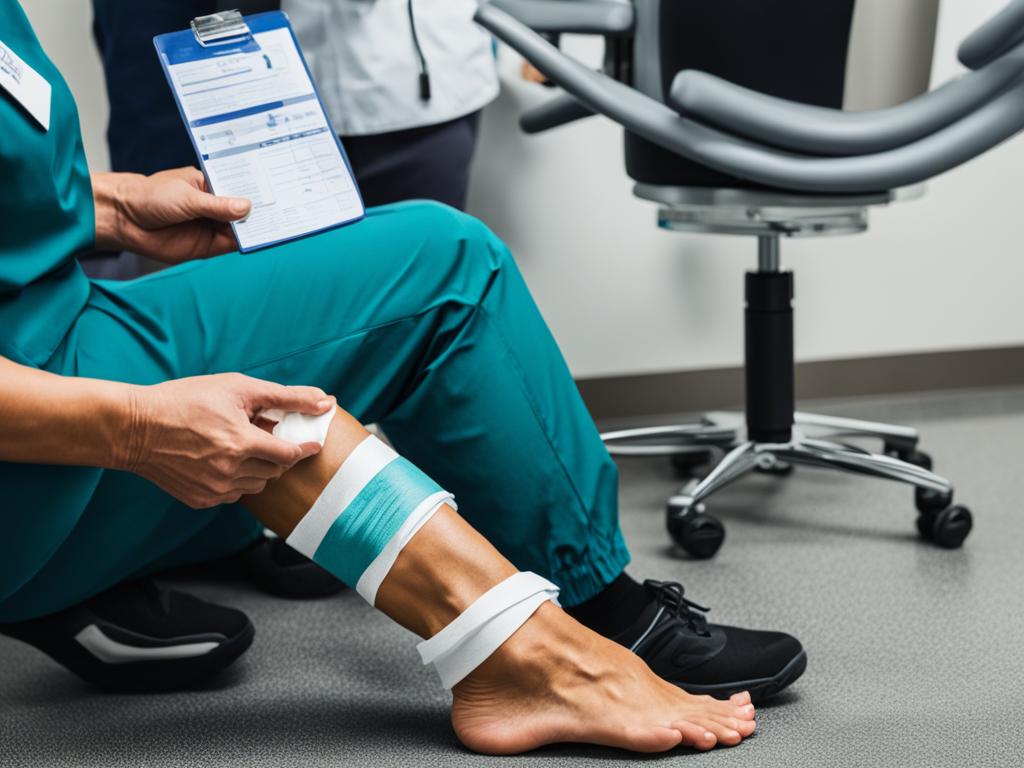Urgent Care Sprained Ankle Treatment Options
When it comes to treating a sprained ankle, urgent care centers provide immediate relief and effective treatment options. With the goal of reducing pain and swelling, promoting healing, and restoring function, urgent care can offer various treatments depending on the severity of the injury.
Key Takeaways:
- Urgent care centers are equipped to diagnose and treat sprained ankles.
- Treatment options vary depending on the severity of the injury.
- Self-care measures and over-the-counter pain relievers can be effective for mild to moderate sprains.
- For severe sprains, referral to a specialist or orthopedic surgeon may be necessary.
- Physical therapy exercises can help restore range of motion and stability to the ankle.
Diagnosis of a Sprained Ankle
To accurately diagnose a sprained ankle, a comprehensive physical examination is conducted by a doctor. During this examination, the doctor will carefully assess the ankle, foot, and lower leg for specific points of tenderness, evaluate the range of motion, and identify positions that cause discomfort or pain. This thorough evaluation helps determine the severity of the sprain and guides the appropriate course of treatment.
In certain cases, additional diagnostic imaging scans may be recommended to further assess the extent of the injury. These imaging techniques can include X-rays, MRIs, CT scans, or ultrasounds. These scans help rule out the possibility of any broken bones and provide a more detailed evaluation of the ligament damage.
When diagnosing a sprained ankle, doctors rely on both physical examinations and imaging tests to accurately assess the injury and develop a tailored treatment plan.
Diagnosis of a Sprained Ankle – Steps
| Step | Description |
|---|---|
| 1 | Physical examination of the ankle, foot, and lower leg |
| 2 | Evaluation of tenderness, range of motion, and positions that cause discomfort or pain |
| 3 | Additional imaging scans recommended (X-rays, MRIs, CT scans, or ultrasounds) |
| 4 | Assessment of ligament damage and ruling out broken bones |
Treatment Options for a Sprained Ankle
When it comes to treating a sprained ankle, there are various options available depending on the severity of the injury. Here are some treatment options that can help alleviate pain, reduce swelling, and promote healing:
Self-Care Measures
For mild to moderate sprained ankles, self-care measures can be highly effective. One popular approach is the R.I.C.E. method, which stands for:
Rest the ankle to avoid further injury.
Ice the affected area to reduce swelling and pain.
Compression with elastic bandages or wraps to provide support.
Elevation of the ankle above heart level to minimize swelling.
Over-the-Counter Pain Relievers
Over-the-counter nonsteroidal anti-inflammatory drugs (NSAIDs) like ibuprofen or acetaminophen can help relieve pain and reduce inflammation. These medications can be used in conjunction with other treatment options to manage discomfort and facilitate the healing process.
Devices for Support and Stabilization
Depending on the severity of the sprained ankle, healthcare professionals may recommend devices to provide support and aid in stabilization. These can include:
- Crutches: Assist in keeping weight off the injured ankle during the recovery period.
- Elastic bandages: Help in compressing the ankle and providing gentle support.
- Ankle support braces: Provide additional stability and protection for the injured ligaments.
Physical Therapy Exercises
Physical therapy is often recommended for sprained ankle recovery, especially for moderate to severe cases. A physical therapist can design a tailored exercise program to promote healing, restore range of motion, and strengthen the surrounding muscles. These exercises may include:
- Stretches to improve flexibility.
- Strength-building exercises to regain stability and prevent future injuries.
- Balance and proprioception training to enhance coordination and prevent re-injury.
Specialist Referral
For severe sprains that do not respond to conservative treatment or for complex cases, referral to a specialist or orthopedic surgeon may be necessary. These healthcare professionals can provide further evaluation and offer advanced treatment options, including surgical intervention if warranted.

| Treatment Options | Benefits |
|---|---|
| Self-Care Measures (R.I.C.E.) | – Effectively reduces pain and swelling. – Easily implemented at home. – Promotes early healing. |
| Over-the-Counter Pain Relievers | – Provides relief from pain and inflammation. – Widely available and easily accessible. – Compatible with other treatment options. |
| Devices for Support and Stabilization | – Helps protect and immobilize the injured ankle. – Facilitates a faster and safer recovery. – Reduces the risk of re-injury. |
| Physical Therapy Exercises | – Restores range of motion and ankle functionality. – Strengthens surrounding muscles for improved stability. – Reduces the likelihood of future ankle sprains. |
| Specialist Referral | – Access to advanced diagnostic tools and medical expertise. – Tailored treatment options for complex cases. – Surgical intervention if conservative treatment fails. |
Medications for Sprained Ankle Pain
When it comes to managing the pain associated with a sprained ankle, over-the-counter medications are often the first line of defense. These medications can help alleviate pain and reduce inflammation, allowing for more comfortable movement and faster healing.
Here are some commonly used medications for sprained ankle pain:
- Ibuprofen: This nonsteroidal anti-inflammatory drug (NSAID) can help relieve pain and reduce swelling. It is available over-the-counter in various strengths.
- Naproxen sodium: Another NSAID that can be effective in reducing pain and inflammation caused by a sprained ankle. It is available over-the-counter without a prescription.
- Acetaminophen: This pain reliever can help alleviate mild to moderate pain associated with a sprained ankle. It is available over-the-counter and is generally safe when taken as directed.
It is important to follow the dosage instructions provided on the packaging and consult with a healthcare professional if you have any underlying medical conditions or are taking other medications. They can offer guidance on the appropriate dosage and duration of medication use.
While over-the-counter medications can provide temporary relief, it is essential to keep in mind that they do not treat the underlying cause of the sprain. It is recommended to consult with a healthcare professional for a proper diagnosis and to discuss the most suitable treatment options for your specific case.
Devices for Stabilizing a Sprained Ankle
When it comes to treating a sprained ankle, stabilizing devices play a crucial role in aiding the healing process and providing support to the injured joint.
Depending on the severity of the sprained ankle, various devices can be used to stabilize the joint and minimize further damage. These devices help immobilize the ankle, reduce pain, and promote proper healing.
Here are some commonly used devices for stabilizing a sprained ankle:
- Elastic bandages: These flexible and adjustable bandages provide compression and support to the injured ankle. They help reduce swelling and immobilize the joint to facilitate healing.
- Sports tape: Athletic tape is often used to provide additional stability to the sprained ankle. It helps restrict excessive movement and prevents further injury during physical activities.
- Ankle support braces: These braces are designed specifically to provide support to the ankle joint. They offer a higher level of stability and protection, making them suitable for moderate to severe sprains.
- Cast or walking boot: In more severe cases, a cast or walking boot may be necessary to fully immobilize the ankle and promote proper healing. These devices help protect the ankle from further injury and provide stability during weight-bearing activities.
By using these devices, individuals with a sprained ankle can minimize pain, reduce swelling, and prevent further damage. It’s essential to consult a healthcare professional to determine the most appropriate device based on the severity of the sprain.

| Device | Benefits |
|---|---|
| Elastic bandages | Provide compression and support to reduce swelling |
| Sports tape | Restrict excessive movement during physical activities |
| Ankle support braces | Offer a higher level of stability and protection |
| Cast or walking boot | Immobilize the ankle and protect it from further injury |
Physical Therapy for Sprained Ankle Recovery
Physical therapy plays a vital role in the recovery process of a sprained ankle. Once the swelling and pain have subsided, it is important to restore range of motion, strength, flexibility, and stability to the affected ankle. Through targeted exercises and guided rehabilitation, physical therapy aims to promote healing and prevent future sprains.
Benefits of Physical Therapy for Sprained Ankle
Physical therapy offers numerous benefits for sprained ankle recovery:
- Restoring Range of Motion: Physical therapy exercises help regain the full range of motion in the ankle joint, enabling normal activities and movement.
- Building Strength: Strengthening exercises target the muscles surrounding the ankle, improving stability and reducing the risk of future injuries.
- Enhancing Flexibility: Stretching exercises increase flexibility, improving overall ankle function and reducing stiffness.
- Improving Stability: Balance and stability training are essential in retraining the ankle muscles, enhancing proprioception, and preventing re-injury.
A professional physical therapist or healthcare provider will create a tailored treatment plan that addresses the specific needs of the patient. The plan may include a combination of exercises, manual therapy techniques, and other therapeutic modalities to optimize recovery.
The Role of a Physical Therapist
“Physical therapists are experts in musculoskeletal rehabilitation and understand the complexities of ankle injuries. They play a critical role in guiding patients through their recovery journey, providing valuable knowledge, support, and personalized care.”
A physical therapist will assess the condition of the sprained ankle, evaluate the patient’s functional limitations, and develop a customized treatment plan. They will guide patients through each exercise, ensuring proper technique and gradually progressing the difficulty level as healing progresses. Regular follow-up appointments allow the physical therapist to monitor progress, make any necessary adjustments, and provide additional guidance for a successful recovery.
Example Physical Therapy Exercises
Here are some common physical therapy exercises used in sprained ankle recovery:
- Toe Raises: This exercise strengthens the muscles in the calf and stabilizes the ankle. By standing up straight and lifting the heels off the ground, patients can effectively target these muscles.
- Ankle Alphabet: This exercise improves ankle mobility and flexibility. Patients can sit down and use their foot to trace the alphabet in the air, moving the ankle joint through its full range of motion.
- Balance Training: Various balance exercises, such as standing on one leg or using a balance board, help improve ankle stability and proprioception.
- Resistance Band Exercises: These exercises involve the use of resistance bands to strengthen the ankle and surrounding muscles. Examples include ankle inversion and eversion exercises.
It is essential to follow the guidance of a physical therapist or healthcare provider when performing these exercises to ensure safety and maximize the benefits.
Surgical Treatment for Persistent Sprained Ankle
In rare cases where the sprained ankle does not heal or remains unstable even after extensive physical therapy, surgery may be necessary. The surgical options can include:
- Repairing a ligament that has not healed.
- Reconstructing a ligament using tissue from nearby ligaments or tendons.
Surgery is usually considered when other treatment methods have not provided the desired results. It aims to restore stability and function to the ankle, allowing for a quicker and more complete recovery.
If surgery is deemed necessary, it is important to consult with an experienced orthopedic surgeon who specializes in foot and ankle procedures. They will evaluate the extent of the damage and recommend the most appropriate surgical approach.
| Surgical Options | Pros | Cons |
|---|---|---|
| Ligament Repair |
|
|
| Ligament Reconstruction |
|
|
As with any surgical procedure, there are risks involved, and the decision to undergo surgery should be made in consultation with a healthcare professional. They will be able to evaluate individual circumstances and provide personalized recommendations for the best course of action.

Choosing Urgent Care for Sprained Ankle Treatment
When it comes to treating a sprained ankle, urgent care centers are a convenient and cost-effective option. They offer immediate care and a range of treatment options, making them a popular choice for those seeking prompt relief. Whether you’re experiencing extreme pain, swelling, or difficulty walking, urgent care can provide the necessary diagnosis and treatment for your sprained ankle.
Some well-known urgent care clinics that provide treatment for sprained ankles include CityMD, ProHealth Circle Urgent Care, and MinuteClinic. These centers are equipped with licensed medical professionals who specialize in diagnosing and treating ankle injuries. They have the expertise and resources to assess the severity of your sprain and recommend appropriate treatment options.
Choosing urgent care for your sprained ankle treatment offers several advantages. First, urgent care centers typically have shorter wait times compared to emergency rooms. This means you can receive the necessary care in a timely manner without having to spend hours waiting. Second, urgent care visits are often more affordable than emergency room visits, making them a cost-effective option, especially for non-life-threatening conditions like sprained ankles.
When you visit an urgent care center for your sprained ankle, the medical staff will conduct a physical examination to assess the extent of the injury and determine the appropriate treatment plan. Depending on the severity of your sprain, treatment options may include the R.I.C.E. approach (rest, ice, compression, elevation), over-the-counter pain relievers, ankle support braces, or referrals for advanced imaging or surgery if necessary.
In addition to providing immediate care, urgent care centers also offer convenience and accessibility. Their extended hours, including weekends and evenings, allow you to seek treatment when it’s most convenient for you, without having to wait for an appointment with your primary care physician or deal with long waits in emergency rooms.
The Benefits of Choosing Urgent Care for Sprained Ankle Treatment:
- Immediate relief and treatment options
- Shorter wait times compared to emergency rooms
- Cost-effective care
- Convenient extended hours
- Accessibility without the need for an appointment
Next time you find yourself with a sprained ankle, consider choosing urgent care for your treatment. With their expertise, prompt care, and convenience, urgent care centers are well-equipped to help you recover and get back on your feet.

Signs and Symptoms of a Sprained Ankle
The signs and symptoms of a sprained ankle can vary depending on the severity of the injury. It is important to be aware of these signs and symptoms to recognize when medical attention is needed.
Common signs and symptoms of a sprained ankle include:
- Pain: Ankle pain, especially when bearing weight or moving the joint.
- Tenderness: Increased sensitivity and pain when touching or pressing on the affected area.
- Swelling: The ankle may become swollen and appear larger than usual.
- Bruising: Skin discoloration, ranging from mild bruising to extensive black and blue marks.
- Restricted Range of Motion: Difficulty moving the ankle through its normal range of motion.
- Instability: A feeling of instability or weakness in the ankle when walking or standing.
- Popping Sensation or Sound: Some individuals may experience a popping sensation or hear a popping sound at the time of injury.
If you are experiencing severe or persistent symptoms, it is crucial to seek medical attention for a proper diagnosis and appropriate treatment. A healthcare professional can assess the extent of the sprain and recommend the best course of action to promote healing and restore functionality.
“Being aware of the signs and symptoms of a sprained ankle can help individuals identify the need for medical attention and ensure proper treatment.” – Dr. Jane Thompson, Orthopedic Specialist

When to Seek Medical Treatment for a Sprained Ankle
While self-care measures can be effective for mild sprained ankles, it is crucial to seek medical treatment if the pain and swelling are extreme or if walking becomes difficult. Seeking prompt medical attention allows for a proper diagnosis and appropriate treatment options, which can significantly improve recovery outcomes. A doctor will be able to assess the severity of the sprain and recommend the most suitable course of action.
Signs to Look Out For:
- Extreme pain
- Severe swelling
- Inability to bear weight on the affected ankle
- Significant bruising
- Ankle instability
- Persistent or worsening symptoms
If you experience any of these signs or symptoms, it is important not to delay seeking medical treatment. Ignoring the severity of a sprained ankle can lead to complications and prolonged healing time. Seeking medical care also enables the doctor to rule out other potential injuries, such as fractures, ligament tears, or joint dislocation, which may require different treatment approaches.
“Timeliness is critical when it comes to sprained ankle treatment. Seeking medical care promptly ensures appropriate diagnosis, prevents further damage, and enhances the chances of a full recovery.” – Dr. Jane Smith, Orthopedic Surgeon
A doctor may recommend additional diagnostic tests, such as X-rays or MRIs, to evaluate the extent of the injury and assess any underlying damage. These imaging tests can provide valuable insights that influence the treatment plan. Based on the severity, the doctor may propose non-surgical interventions, such as immobilization with a brace or a cast, physical therapy exercises, or anti-inflammatory medication.
Remember, seeking medical treatment for a sprained ankle is not a sign of weakness but a proactive step towards optimal recovery. Don’t hesitate to consult with a healthcare professional who can provide the expertise and guidance needed for an effective treatment strategy.

| Mild Sprain | Moderate Sprain | Severe Sprain |
|---|---|---|
| Minimal pain and swelling | Increased pain and swelling | Extreme pain and swelling |
| Mild difficulty walking or bearing weight | Difficult walking or bearing weight | Unable to walk or bear weight |
| No bruising or mild discoloration | Visible bruising | Significant bruising |
| Stable ankle | Moderate instability | Severe instability |
Prompt Treatment for a Sprained Ankle
Seeking prompt treatment for a sprained ankle is crucial to prevent further damage and complications. Delaying treatment can result in chronic ankle pain, instability, and even arthritis. Timely care, such as visiting an urgent care center like vybe, allows for a proper diagnosis, effective pain management, and the implementation of appropriate treatment options like rest, ice, compression, elevation, and physical therapy exercises.

When it comes to a sprained ankle, time is of the essence. The sooner you seek medical attention and receive proper treatment, the better chances for a full recovery. Prompt treatment can help reduce pain, swelling, and inflammation, allowing the healing process to begin. It also helps prevent complications and long-term consequences, such as chronic pain and instability.
Urgent care centers, like vybe, provide convenient and accessible options for prompt sprained ankle treatment. They have experienced healthcare professionals who can diagnose the severity of the injury and recommend appropriate treatment options. Whether it’s a mild sprain that can be managed with rest and self-care or a more severe sprain that requires additional interventions, urgent care centers are well-equipped to handle sprained ankle cases.
Benefits of Prompt Treatment:
- Reduces pain, swelling, and inflammation
- Initiates the healing process
- Prevents long-term complications
- Promotes faster recovery
- Restores ankle function and stability
If you’ve recently sprained your ankle, don’t delay seeking treatment. Visit an urgent care center like vybe for prompt evaluation and proper care. The healthcare professionals will assess your injury, provide pain management strategies, and guide you through the necessary treatment steps for a successful recovery.
Urgent Care Diagnosis and Treatment for Sprained Ankle
When it comes to sprained ankle injuries, urgent care centers like vybe offer comprehensive diagnosis and treatment options. With licensed medical professionals and efficient resources, they provide prompt care to alleviate pain and support the healing process.
Diagnosis begins with a thorough physical examination conducted by the medical professionals at urgent care centers. They assess the injured ankle, evaluate range of motion, and perform necessary tests to determine the extent of the injury. This may involve digital X-rays or other imaging techniques to accurately diagnose the sprain.
Once diagnosed, urgent care centers provide a range of treatment options tailored to the individual patient’s needs. Commonly recommended treatments include the R.I.C.E. method: rest, ice, compression, and elevation. Additionally, over-the-counter pain relievers can help manage discomfort and reduce inflammation.
To promote stability during the healing process, urgent care centers may provide splints or braces for the sprained ankle. These devices offer support and protection while minimizing movement that could further strain the injured ligaments.
If further evaluation is needed, urgent care centers can refer patients for advanced imaging or surgical consultations. This ensures that patients receive the appropriate treatment for their specific needs, whether it be further diagnostics or specialized interventions.
Table: Comparison of Diagnosis and Treatment Options Offered by Urgent Care Centers for Sprained Ankles
| Diagnosis and Treatment Options | Benefits |
|---|---|
| Thorough physical examination | Accurate assessment of the sprain, guiding appropriate treatment |
| Digital X-rays and imaging tests | Precise evaluation of the injury and ruling out any additional damage |
| R.I.C.E. method (rest, ice, compression, elevation) | Effective pain relief, reduced swelling, and accelerated healing |
| Over-the-counter pain relievers | Management of discomfort and inflammation |
| Splints or braces | Stabilization of the sprained ankle, preventing further strain |
| Referral for advanced imaging or surgery | Ensuring comprehensive evaluation and specialized interventions if necessary |
With their efficient diagnosis and personalized treatment approaches, urgent care centers play a vital role in providing effective and convenient care for sprained ankles.

Conclusion
Sprained ankles are common injuries that require prompt and appropriate treatment for optimal recovery. Thankfully, urgent care centers offer convenient and cost-effective options for diagnosing and treating sprained ankles. By utilizing a range of treatments, from self-care measures and pain management to physical therapy exercises and, in rare cases, surgical interventions, the primary goals are to reduce pain, swelling, and instability while promoting healing and restoring function to the ankle.
Timely care plays a crucial role in ensuring a quick return to daily activities and minimizing the risk of long-term complications. Seeking medical attention as soon as possible allows for a proper diagnosis, timely intervention, and the implementation of effective treatment options. Urgent care centers, like vybe, with their licensed medical professionals, provide thorough examinations, range of motion assessments, and can perform digital X-rays or other imaging tests to evaluate the severity of the injury. Treatment options at urgent care centers may include the R.I.C.E. method, over-the-counter pain relievers, splints or braces for stabilization, and referrals for advanced imaging or surgery if necessary.
In conclusion, sprained ankles should never be ignored or left untreated. With the assistance of urgent care centers, individuals can receive the prompt and appropriate care they need to recover fully. Whether it’s a mild sprain or a more severe injury, seeking timely treatment ensures a faster and smoother recovery process, allowing patients to resume their daily activities with confidence while minimizing the risk of long-lasting complications.
FAQ
What are the treatment options for a sprained ankle at urgent care centers?
Urgent care centers provide various treatment options for sprained ankles, including the R.I.C.E. approach (rest, ice, compression, elevation), over-the-counter pain relievers, ankle support braces, and physical therapy exercises.
How is a sprained ankle diagnosed?
A sprained ankle is diagnosed through a physical examination conducted by a doctor. In some cases, imaging scans such as X-rays, MRIs, CT scans, or ultrasounds may be recommended.
What medications can be used for sprained ankle pain?
Over-the-counter pain relievers such as ibuprofen, naproxen sodium, or acetaminophen are commonly used to manage pain associated with a sprained ankle.
What devices are used to stabilize a sprained ankle?
Various devices can be used to stabilize a sprained ankle, including elastic bandages, sports tape, ankle support braces, and, in severe cases, a cast or walking boot.
What is the role of physical therapy in sprained ankle recovery?
Physical therapy plays a crucial role in sprained ankle recovery by restoring range of motion, strength, flexibility, and stability to the ankle through exercises and balance training.
When is surgery necessary for a sprained ankle?
Surgery for a sprained ankle is rare but may be necessary if the ankle does not heal or remains unstable after extensive physical therapy. Surgical options include ligament repair or reconstruction.
Why should I choose urgent care for sprained ankle treatment?
Urgent care centers offer convenient and cost-effective treatment options for sprained ankles, with licensed medical professionals who can diagnose and provide appropriate treatment options.
What are the signs and symptoms of a sprained ankle?
The signs and symptoms of a sprained ankle include pain, tenderness, swelling, bruising, restricted range of motion, instability, and a popping sensation or sound at the time of injury.
When should I seek medical treatment for a sprained ankle?
Medical treatment should be sought if the pain and swelling are extreme or if walking becomes difficult. Delaying treatment can lead to complications and prolonged healing time.
How important is prompt treatment for a sprained ankle?
Seeking prompt treatment for a sprained ankle is crucial to prevent further damage and complications. Timely care allows for a proper diagnosis, effective pain management, and the implementation of appropriate treatment options.
How can urgent care diagnose and treat a sprained ankle?
Urgent care centers have licensed medical professionals who can diagnose and provide treatment options for a sprained ankle. They conduct physical examinations, assess range of motion, and may perform imaging tests if needed.




